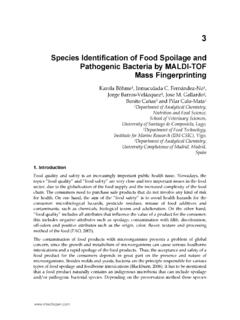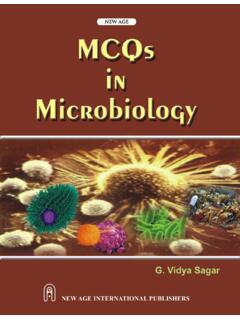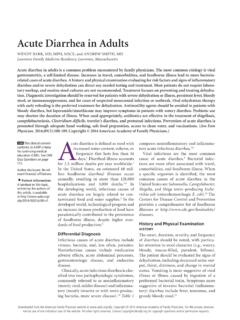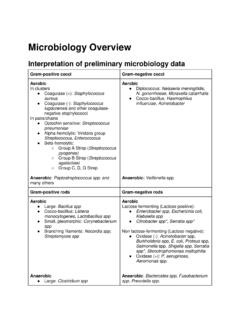Transcription of Edible Insects - Future prospects for food and feed security
1 117. 10. food safety and preservation food safety, processing and preservation are closely related. Insects , like many meat products, are rich in nutrients and moisture, providing a favourable environment for microbial survival and growth (Klunder et al., 2012). Traditional processing methods, such as boiling, roasting and frying, are often applied to improve the taste and palatability of Edible Insects and have the added advantage of ensuring a safe food product. Cultural preferences and organoleptic (sensory) aspects play important roles in chosen preservation methods.
2 Although a wide variety of modern preservation methods is available, specific measures to ensure a high-quality and safe food item may be required for different insect species, depending on their biological makeup. Determining optimal preservation methods will be a critical factor in the commercialization of Edible Insects on a global scale, be it for food or feed. In this chapter the main focus is on food ; however, the same also applies for feed. The Hazard Analysis Critical Control Points (HACCP) system, a science-based and systematic tool, identifies specific hazards and establishes control systems to ensure the safety of food (FAO/WHO, 2001a).
3 Its focus is preventative in nature, rather than relying mainly on end-product testing. HACCP is recognized worldwide as a system for quality assurance, identifying, evaluating and controlling physical, chemical and biological hazards throughout the production process. The system can be applied across the food chain, from primary production to final consumption. As well as increasing food safety, the application of HACCP can aid inspection by regulatory authorities and promote international trade by increasing confidence in food safety.
4 For these reasons, the adoption of HACCP throughout the insect supply chain will be a determining factor in the success and development of the Edible insect sector. According to FAO, any HACCP system is capable of accommodating change, such as advances in equipment design, processing procedures or technological developments . (FAO/IAEA, 2001). Although it has been stated that no significant health problems have arisen from the consumption of Edible Insects (Banjo, Lawal and Songonuga, 2006b), consumer confidence is arguably strongly correlated with the perceived safety of a given product.
5 In this vein, the application of pesticides on Insects destined for the food sector raises important issues, both for nutritional security and participation in the global market. It is well documented that species caught in fields, for example, are more likely to contain pesticides or heavy metals than those collected in dense forests. Chapulines (Sphenarium purpurascens) red grasshoppers typically harvested in regions like Oaxaca, Mexico . have been found to contain high concentrations of lead from nearby mines (Handley, 2007).
6 Many countries in Africa do not have policies governing the use of chemicals in fields in areas where villagers collect Edible Insects . Most of the time, collection takes place with little knowledge of the consequences that eating chemically treated Insects might have (Ayieko et al., 2012) (for more information on this topic, see Chapter 12). However, food -safety issues are important not only for Insects collected in the wild but also for farmed Insects . Preservation and storage Insects are often consumed quickly after harvesting.
7 Some Insects are commercialized and transported within countries or beyond national borders for sale in distant markets;. this is not uncommon between the Lao People's Democratic Republic and Thailand, 118 Edible Insects : Future prospects for food and feed security for example. Live Insects , after washing, are typically transported in ice coolers shortly after collection. Refrigeration is also recommended for fried and boiled Insects . Insects can be preserved and traded after (sun-)drying a typical method used in processing the mopane caterpillar, for example (Allotey and Mpuchane, 2003) (Box ).
8 The dry environments typically found in places where sun-drying is common practice limits the growth of most micro-organisms. In humid areas, however, even sun-dried caterpillars are susceptible to moisture, which can stimulate the growth of microbes. Insects can also be re-contaminated during the drying process through air or soil;. for this reason, hygienic practices during processing are of great importance and an additional heating/cooling step is recommended before consumption (Amadi et al., 2005;. Giaccone, 2005). In many parts of the world, ready-to-eat Insects are often sold in local markets after frying or roasting.
9 In such cases, hygienic handling is equally important to prevent the potential risk of re-contamination and cross-contamination. At a household level, fresh Insects should be prepared hygienically and sufficient heat treatment applied to ensure a microbiologically safe food product. Other simple preservation methods such as acidifying the Insects with vinegar have been successful. Another example is the use of Insects for protein enrichment in fermented food products. This is a viable processing option with mutual bene ts, since the decreased pH in lactic acid-fermented products prevents the growth of potentially harmful micro-organisms (Klunder et al.)
10 , 2012). There has been some success in processing and commercializing Insects in the Netherlands. Three insect species (yellow mealworm larvae, lesser mealworm larvae and migratory locusts) can be found in specialized shops in the country that are produced and processed specifically for human consumption. One-day fasting is applied to ensure that the insect has an empty gut (degutting), and the insect is then freeze-dried whole. This produces a safe product with a relatively long shelf life (one year), if stored appropriately in a cool, dry place.
















